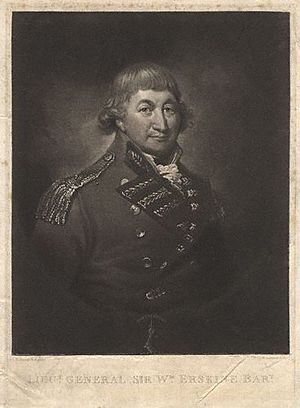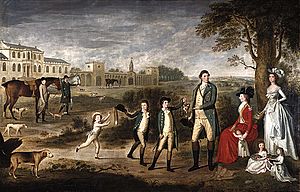Sir William Erskine, 1st Baronet facts for kids
Quick facts for kids
Sir William Erskine, 1st Baronet
|
|
|---|---|

Sir William Erskine, 1st Baronet, from a print in the NPG.
|
|
| Nickname(s) | Woolly |
| Born | 1719 England |
| Died | 19 March 1795 (aged 75–76) |
| Allegiance | |
| Service/ |
|
| Years of service | 1742–1795 |
| Rank | Lieutenant-General |
| Commands held | 15th Light Dragoons
80th (Royal Edinburgh Volunteers) 26th (Cameronian) Regiment of Foot |
| Battles/wars | |

Sir William Erskine (1728 – 19 March 1795) was a brave British Army officer. He became a Lieutenant-General, which is a very high rank in the army. He was also the first Baronet of Erskine of Torrie, a special title given by the King.
Contents
Early Life and Military Start
William Erskine was born in 1728. His father, Colonel William Erskine, was also a military man. This meant William grew up around army life.
He joined the army in 1742, following in his father's footsteps. His first regiment was the 7th Dragoons. He quickly saw action in important conflicts.
Fighting in Europe
Erskine fought in the War of the Austrian Succession. One of his first big battles was the Battle of Fontenoy. Later, he served in the Seven Years' War.
By 1759, he was a Major in the 15th Light Dragoons. He became a Lieutenant-Colonel in 1762, leading his own regiment. He showed great skill at the Battle of Emsdorf. After this battle, he was even able to show King George III 16 captured flags! For his bravery and success, he was made a knight.
Serving in the American Revolutionary War
In 1776, Sir William Erskine went to America. He was a senior officer during the American Revolutionary War. He fought in the New York campaign.
Key Battles in America
Erskine commanded the 7th Brigade at the Battle of Long Island in August 1776. He later became the Quartermaster-General for Lord Cornwallis. This role meant he was in charge of supplies and logistics for the army.
He gave important advice at the Battle of the Assunpink Creek. He suggested attacking the American army right away. However, the American forces slipped away that night.
In 1777, Erskine became a Brigadier-General. He helped lead a raid in Danbury, Connecticut. His forces destroyed American supplies there. They also won the Battle of Ridgefield against American generals.
Erskine continued to serve in the Philadelphia campaign. He then worked under Henry Clinton. He led troops at the Battle of Monmouth. After this, he commanded the eastern part of Long Island.
His last duty in America was chasing the American army in November 1778. He was promoted to Major-General in 1779 and then sailed back to London.
Wars Against Revolutionary France
In 1782, Erskine became the Colonel-in-Chief of the 26th Foot regiment. He was promoted to Lieutenant-General in 1787. In 1791, he received the special title of Baronet.
Campaigns in Flanders
When war broke out with revolutionary France, Erskine joined the Duke of York in the Flanders Campaign in 1793.
He was part of the Siege of Dunkirk. He also led the army's retreat after the Battle of Hondschoote. Erskine even commanded the army when the Duke of York was away during the winter of 1793-1794.
In the spring of 1794, he commanded the Duke of York's right wing. He fought bravely at the Battle of Tourcoing and later at Tournai.
Later Life and Nickname
Sir William Erskine passed away on March 19, 1795, at the age of 67. He is buried in Torryburn, Fife.
In the army, he was known by the nickname "Woolly" Erskine.
Images for kids


